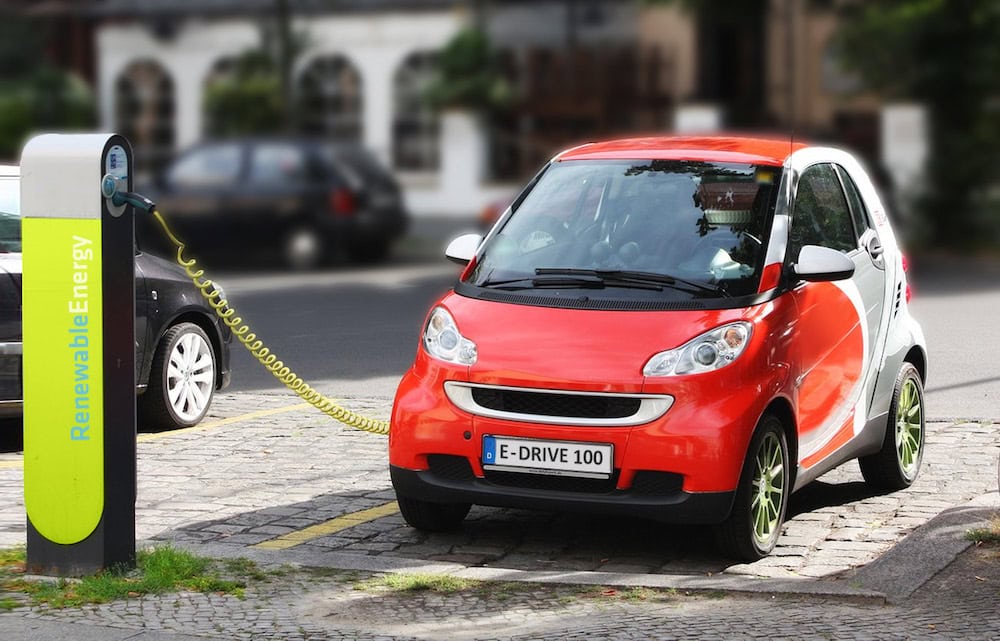
[Image above] Could electric vehicles be powered by cobalt-free batteries in the future? Credit: Michael Movchin and Felix Müller, Wikimedia (CC BY-SA 3.0)
I remember vividly the first time I became aware of the ethical issues surrounding cobalt mining.
Cobalt is a key ingredient in lithium-ion batteries, specifically ones with cathodes made from nickel-cobalt-manganese (NCM) or nickel-cobalt-aluminum (NCA). Cobalt stabilizes the cathode by compensating for the charge when lithium ions arrive or depart during cycling.
Over the past decade, lithium-ion batteries with NCM and NCA cathodes solidified their status as the battery of choice for power tools and electric vehicles because of their high energy density, i.e., the amount of energy stored per unit volume. And with significant expansion of EV sales in the past 10 years, the demand for cobalt has increased—bringing the issues with cobalt mining into sharp focus.
In 2018, I read an article by Fortune magazine looking at cobalt mining in the Democratic Republic of the Congo (DRC), a country that produces more than 60% of the world’s cobalt. A significant amount of cobalt in the DRC is mined by children, and the Fortune article included interviews with some of the children to illustrate the problem.
As knowledge of the children miners became widespread, some of the world’s largest tech companies were sued for their complicity in the matter, a lawsuit that is ongoing. And these ethical concerns—in addition to health and environmental impacts and potential future supply shortages—have driven companies to begin seriously considering alternative batteries that are cobalt-free.
Tesla, for example, is exploring using lithium iron phosphate (LFP) batteries in its China-made Model 3 vehicles. LFP batteries are well known in stationary energy storage applications but are not traditionally used in EVs because of their low energy density (a disadvantage the Tesla batteries are expected to face as well).
Ideally, a cobalt-free battery would have energy density equivalent or better than the NCM and NCA batteries because it would allow a car to go longer between charges. And theoretically, a cobalt-free nickel-based battery would be a good way to achieve that because nickel provides high energy density.
Unfortunately, nickel is unstable by itself and requires other elements to stabilize the cathode. And only cobalt, aluminum, and manganese appear to stabilize it without severe side effects.
“While elements such as magnesium, zirconium and titanium are routinely introduced in commercial high-Ni layered oxides for performance tuning … optimal amounts are typically very small, sometimes down to ppm levels, as detriments often coincide with benefits,” researchers write in a recent perspective article. “Large usage can give rise to substantial structural defects (for example, cation mixing), lattice distortion and impurities, severely worsening electro-chemical properties.”
The researchers come from the University of Texas at Austin and are led by Arumugam Manthiram, ACerS Fellow and Cockrell Family Regents Chair in Engineering and director of the Texas Materials Institute.
In the perspective article, the researchers discuss several important design considerations for high-nickel layered oxide cathodes and make an interesting suggestion—if aluminum and manganese are known to stabilize nickel well, as evidenced by NCM and NCA batteries, why not create a nickel-based cathode that ditches cobalt and combines aluminum and manganese instead?
In a new paper published this month, Manthiram, postdoctoral fellow Wangda Li, and graduate student Steven Lee explored the potential of lithium-ion batteries featuring nickel-manganese-aluminum (NMA) cathodes, a combination that “strikingly” has not been reported to their knowledge.
They compared the composition NMA-89 (nickel content 89%) to NMC-89, NCA-89, and aluminum-magnesium codoped NMC (NMCAM-89) and made several notable findings.
Lower specific capacity, higher average voltage
Despite a marginally lower specific capacity, i.e., amount of charge stored per unit volume, NMA-89 showed a higher average voltage of nearly 40 mV more than NMC-89.
(Transmitting power at high voltages is desirable because it increases efficiency. Why? The higher the voltage, the lower the current. And the lower the current, the lower resistance losses in the conductors. When resistance losses are low, energy losses are low as well.)
Fast discharging performance
Rate capability, or the rate a battery charges/discharges, is another key performance metric in addition to energy density. And the fast-discharging performance of NMA-89 is very similar to that of NMC-89 and NCA-89.
Comparable retained capacity
After 100 cycles at a charge/discharge rate of 1/3, i.e., every 3 hours, NMA-89 retained 90% of its original capacity, which falls right in line with NMCAM-89 (93%), NMC-89 (91%), and NCA-89 (88%).
In the conclusion, the researchers note electrochemical characterization in this study is only preliminary. “…future work is needed to fully understand the benefits and detriments of Mn-Al cosubstitution in high-Ni layered oxides in the absence of [cobalt],” they write.
In an email, Manthiram says they are in the process of analyzing the electrodes after 1,000 cycles with state-of-the-art characterization techniques to better understand materials behavior in the battery during repeated cycling. In addition, they are carrying out further studies to refine the compositions and scale-up the production process. Details on how they plan to bring the technology to market can be seen in the university press release.
The paper, published in Advanced Materials, is “High‐nickel NMA: A cobalt‐free alternative to NMC and NCA cathodes for lithium‐ion batteries” (DOI 10.1002/adma.202002718).
Update 07/19/2020 – Corrected to state that a charge/discharge rate of 1/3 is equal to 3 hours
Author
Lisa McDonald
CTT Categories
- Energy
- Environment


